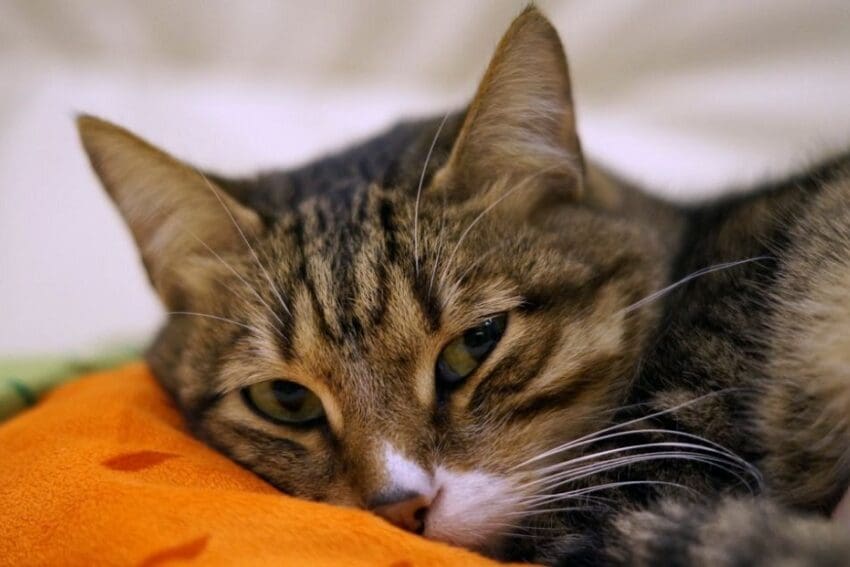Last Updated: 2 years ago
Cats are known for their stoic nature, but that doesn’t mean they don’t feel pain.
As a cat owner, it’s important to know how to tell if a cat is in pain so you can provide the necessary care and treatment.
Learning how to tell if a cat is in pain can help you identify potential health issues early on and ensure your pet stays healthy and happy.
How to Tell If a Cat is in Pain

When it comes to our beloved cats, we want them to be happy and healthy. Unfortunately, cats can’t tell us when they are in pain or feeling discomfort.
As cat owners, it is important that we pay attention to any changes in behavior that may indicate our furry friends are not feeling well. Changes in behavior are often the first sign that your cat is in pain.
Look for signs of lethargy, decreased appetite, and changes in grooming habits. If your cat is usually active and playful but suddenly becomes withdrawn and inactive, this could be a sign of pain.
Other behaviors, such as hiding from people or other animals, may also indicate distress.
Additionally, if you notice your cat limping or having difficulty jumping up onto furniture, this could be an indication of joint pain or arthritis.
It’s always better to err on the side of caution than wait until symptoms become more severe. Seek medical help for your pet if you observe these changes in behavior.
Check for Physical Signs of Pain
The most common physical signs of pain in cats include increased vocalization, lethargy, and reduced appetite. If you notice your cat meowing more than usual or not eating like normal, these could be indicators that something is wrong.
Additionally, if your cat seems unusually tired or sluggish compared to how they usually act, this could also mean there is an underlying issue causing them discomfort.
It’s important to remember that some health conditions, such as arthritis or kidney disease, can cause chronic pain in cats and should always be taken seriously.
Other causes of acute pain may include injuries from fights with other animals or trauma caused by accidents, such as falls from high places.
In either case, it’s best to get a professional opinion on what might be causing the problem so you can take appropriate action accordingly.
By being vigilant about looking out for any physical signs of pain, we can help ensure our cats stay happy and healthy.
Reading Your Cat’s Facial Expressions and Body Language
Cats are mysterious creatures, and it can be difficult to understand what they’re thinking or feeling.
But with a little bit of observation and knowledge, you can learn to read your cat’s facial expressions and body language like an open book.
Facial Expressions
Cats use their faces to communicate in subtle ways that we may not always recognize.
For example, when a cat is relaxed and content, its eyes will appear half-closed while its mouth is slightly open. This expression indicates that the cat feels safe and secure in its environment.
On the other hand, if your cat’s eyes are wide open with dilated pupils, this could indicate fear or aggression.
Additionally, cats often show affection by blinking slowly at you. This behavior is known as kitty kisses!
Body Language
Your feline friend also communicates through body language, with tail position being one of the most important indicators of how they’re feeling.
A tail held high usually means confidence, while a tail tucked between the legs suggests insecurity or fearfulness.
If your cat has its ears flattened against its head, then it may be angry or scared. However, if their ears are perked up, they will likely feel curious about something around them.
Finally, purring typically signifies happiness but can also indicate pain, depending on the situation. Pay attention to other signs that accompany purring, such as hiding away from people or avoiding contact altogether.
Understanding how cats express themselves helps us build stronger relationships with our furry friends, so make sure you observe closely next time you interact with your feline companion.

When to Seek Veterinary Care
To ensure your cat’s health and well-being, it is essential to recognize when something isn’t quite right with them and seek help from a professional veterinarian.
One of the most common signs of pain in cats is increased vocalization. If you notice that your usually quiet kitty has suddenly become more vocal than usual, this could indicate discomfort or pain.
Similarly, if your normally friendly feline starts exhibiting aggressive behaviors towards people or other animals around them, this could also signal an underlying issue requiring medical attention.
Physical signs, such as limping or difficulty moving, can also point to potential issues with your cat’s health.
Other indications include excessive grooming, hiding away more often, reduced appetite, weight loss, panting, drooling, trembling, dilated pupils, and unusual eye movements like squinting.
If you observe any of these changes in behavior or appearance in your cat, please consult with your veterinarian.
Catching problems early on will not only help keep your cat healthy, but it will also reduce stress levels for you.
Conclusion
It is important to be aware of the signs that your cat may be in pain, as this can help you identify and address any potential health issues.
By paying attention to changes in behavior, physical signs of pain, and unique facial expressions and body language, you will be better equipped to tell if a cat is in pain.
Being able to recognize these signs can ensure that your pet receives the proper treatment they need for a speedy recovery.
